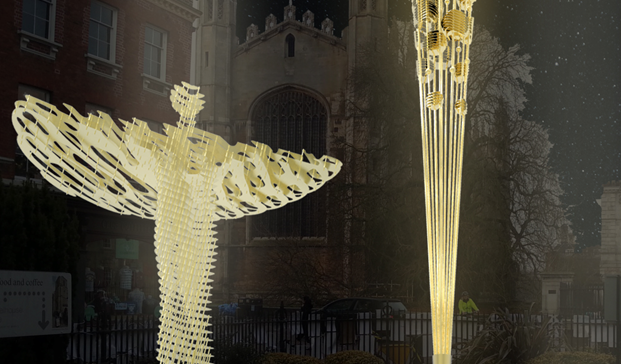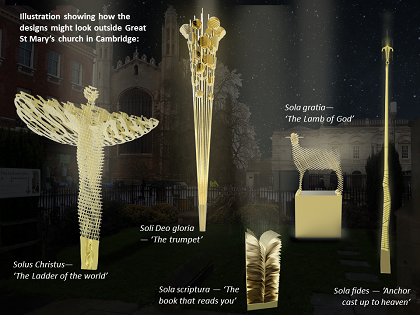There are three great benefits of art, which every Christian should embrace: beauty, truth and imagination.
 A detail of the Five Foundations exhibition, by Liviu Mocan.
A detail of the Five Foundations exhibition, by Liviu Mocan.
As a research-based organisation promoting Christian social reform, it’s not surprising that Jubilee Centre’s output is primarily in the form of words. However, personal and social transformation are unlikely to take place through words alone – no matter how eloquent our language or convincing our arguments.
Sgt Pepper’s Lonely Hearts Club Band was released 50 years ago. Around the same time as the Beatles were recording this epoch-shaping album, Francis Schaeffer was in discussion with many people who came to L’Abri in the Swiss village of Huemoz, trying to make sense of reality. He understood then how crucial the arts were to influencing the way people viewed the world, and urged Protestant Christians to rediscover God’s purposes for this neglected sphere of life.
Since then the evangelical Church has been slowly re-engaging with the arts, which have subsequently become central to postmodern culture. We live in a highly visual age, and so the power of art to reach the soul and touch the heart is becoming more and more important.
I suggest that there are three great benefits of art, which every Christian should embrace.
Beauty. Despite the rejection of beauty by many modern and postmodern artists, our God-given longing for beauty has not diminished. The philosopher Roger Scruton states, “The great artists of the past were aware that human life is full of chaos and suffering. But they had a remedy for this, and the name of that remedy was beauty. The beautiful work of art brings consolation in sorrow and affirmation in joy – it shows human life to be worthwhile. However, many modern artists have become weary of this sacred task.” By bringing beauty into all that we make and do, we enjoy the material world more and honour God as the source of all that’s beautiful, both in creation and redemption (see also Phil 4:8).
Truth. Art can bring us closer to reality, both positively and negatively. A fresco in a Romanian Orthodox church depicts Jesus raising to life the widow of Nain’s son. Surprisingly, perhaps, the boy and his mother were not gazing in awe at Jesus, but at each other in gratitude and wonder; Jesus was almost a bystander. The artist is revealing the truth of God’s relational purpose in the gospel. In contrast, Chinese dissident Ai Weiwei invites people to engage emotionally with real injustice. His 90 tonne installation ‘Straight’ is made entirely from the iron reinforcing bars recovered from the poorly-built schools that collapsed in the Sichuan earthquake of 2008 – killing over 5,000 children – which the authorities tried to hide. This simple installation confronts us with reality in multiple ways.
Imagination. Faith and imagination belong together; Hebrews 11:1 says that faith is being sure of what we hope for, certain of what we do not see. Through combining beauty and truth, and giving form to something which we long for, the arts can help strengthen our faith, deepen our worship, and affirm that there is much more to reality than what we see.
Art speaks the language of the soul; it has the subversive power to bypass our rational defences and speak to the heart – which is the wellspring of life (Proverbs 4:23). Thomas Cranmer, one of the 16th century English Reformers, wrote, ‘What the heart loves, the will chooses, and the mind justifies.’
 Summary of the Five Foundations exhibition, by Liviu Mocan.
Summary of the Five Foundations exhibition, by Liviu Mocan. In light of this, we are delighted to be organising ‘Five Foundations’, a sculpture exhibition marking the 500thanniversary of the Reformation – which will stand opposite Kings College Chapel in Cambridge.
The Romanian artist Liviu Mocan is creating a set of sculptures representing the five solas that summarise the Reformers’ vision for salvation: sola scriptura(by scripture alone), sola fide (by faith alone), sola gratia (by grace alone), solus Christus (through Christ alone) and soli Deo gloria (glory to God alone).
Expressing core theological truths in the form of public sculptures offers a unique window for exploring the Reformation and its legacy. We will be recruiting volunteers to spend time at the sculptures talking to visitors who stop to look – about the Reformation itself, its connection to Cambridge and how it went on to influence so many aspects of society (such as universal education and literacy, human dignity and the equality of all people, the development of literature and the rise of modern science).
Our prayer is that thousands of people will be touched by this unique exhibition that weaves together history, faith and contemporary art. As I write, Liviu is working hard to complete the sculptures, and we’re hoping that we can install them before the summer is over. We believe the sculptures will not only impact visitors to Cambridge, but if they catch the attention of local and national media, the exhibition could add a significant dimension to the 500th anniversary of Luther’s 95 theses on 31st October and beyond.
More details, including two short videos introducing the exhibition and Liviu Mocan, are here.
Jonathan Tame, Director of the Jubilee Centre (Cambridge, UK).
This article first appeared on the Jubilee Centre website and was republished with permission.

Las opiniones vertidas por nuestros colaboradores se realizan a nivel personal, pudiendo coincidir o no con la postura de la dirección de Protestante Digital.
Si quieres comentar o